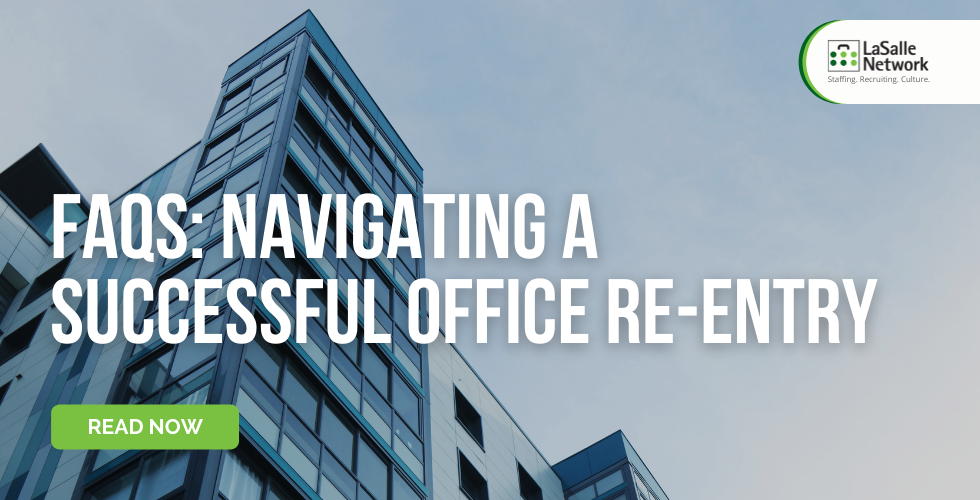In May of 2021, we hosted a virtual event on office re-entry with a panel of HR leaders, who each shared the obstacles and opportunities each of their companies faced when bringing employees back into the office. (To download the recording of the conversation, click here, and to read a recap of the event, click here.)
As many companies like Google and Apple are now deciding to bring their people back to the office, we’re sharing answers to the most pressing questions attendees asked on how to bring employees back safely.
How can you determine who can work remote permanently, versus those needing to work on-site? How can you handle the conversation around having different expectations for different employees?
Each company’s remote-work policies will vary. For many, leaders are deciding who to bring back to the office based on their ability to do their job well from home, balanced with the value of them coming into the office. Consider which employees need to be on-site to perform certain tasks or learn from others, or who need access to various on-site technologies. For employees who are part of highly collaborative teams, many companies are having them come into the office for collaboration days. For more information on how companies have decided who to bring back first, click here.
To discuss different expectations for employees, managers can share why they have decided on their remote-work policies and how they believe employees will benefit from either being in the office or remote. Leaders can share that neither is a punishment, but a decision made to help both the employee’s development and the business’ performance. Helping both virtual and on-site employees set ambitious goals and offering growth and development opportunities appropriate to their work style can help get employee buy-in to new policies and increase engagement.
For more leadership communication strategies regarding office re-entry, click here.
What are ways to help staff indicate they are not comfortable being close to someone else in the office when approached by a peer?
Companies may consider establishing regulated norms around what social distancing measures will look like in the office, especially regarding mask-wearing and use of common spaces. Especially for familial office cultures and environments where a hug, high-five, or pat on the back was normal pre-pandemic, it may be important for leadership to decide what contact should be avoided ahead of time and communicate that clearly company-wide prior to re-entry. It should also be communicated that each person will have a different level of comfortability, and they should respect their colleague’s choices without judgement.
Leaders may also communicate how employees can best assess when contact is appropriate, and when the other party would prefer space. For instance, employees should assess the body language of the other person and respect when they maintain their distance and do not extend their hand for a handshake or lean in for a hug.
Do you expect remote work productivity to decline post-pandemic? If so, do you foresee a greater return to office and less hybrid?
At the height of the pandemic, many cities were shut down to varying degrees, leaving many professionals with few distractions as there was little to do. There were countless reports and stories of employees being more productive during this time; however, there is a stark contrast to the future as we approach mass vaccine distribution and cities beginning to open. In comparison to last year, leaders may need to prepare for a more distracted and less productive workforce moving forward in remote work.
If employee productivity falters or companies do not perform like they were prior to or during the pandemic, leaders will need to make changes to course correct. For some businesses this may mean returning to the office. In fact, according to a poll during the virtual event, 20% of businesses have decided to move up their office re-entry date. Many of these decisions will be dictated by profits post-pandemic.
For additional tips on how managers can help promote productivity and engagement, click here.
If business and client needs can be met with a virtual workforce, do you see a reason to not remain virtual?
Businesses will have varying reasons to either return to the office or stay partially or fully remote, however, according to our data collected from business leaders in March, the majority of businesses planned to have employees back in the office by this fall. Some businesses have adopted a ‘flexibility first’ model to continue to allow employees to work remotely some or all the time and will evaluate the efficacy of this model throughout the year. This will likely include watching for productivity or revenue changes, gauging if remote work remains a sustainable option.
For many companies, the office is not only about business and client needs. It is also key in promoting employee growth and development, engagement, culture and innovation. While communication and collaboration may be possible virtually, many companies still see greater value in the conversations and problem-solving that comes about in the office when working face-to-face.
Especially for new hires or employees taking on new responsibilities, being on-site and able to listen to and observe others is often key in their professional development. Being able to easily troubleshoot issues live and hear conversations or see the work of others can help employees get up to speed and excel in their role more quickly than if isolated working remotely.
Click here to read additional reasons why we believe many companies will return to the office.
How can we maintain culture in a much more virtual workforce than the past?
Whether supporting an entirely remote workforce or a hybrid of on-site and virtual employees, company culture may look different than it did pre-pandemic. For a remote or hybrid workforce, companies cannot utilize the perks, such as catered lunches, unique offices, kegs or game rooms that some businesses once used to encourage team bonding. In a hybrid workforce, it will be even more essential that leaders are trained to cultivate community within their teams. Managers should communicate with their people to ask what they need support in and what they’d like to see more or less of.
Another important aspect of cultivating a strong company culture is ensuring new hires have an effective cultural onboarding as a part of their training process. This could include formal review of company values and norms, as well as culture building activities to get new hires engrained in the community quickly and introduced to tenured employees as well. For advice on how to successfully re-onboard employees post pandemic, click here.
It will be important to make unique and engaging culture-building activities a regular occurrence to bring people together. It may also be helpful to refresh new and tenured employees on communication norms and collaboration strategies. For considerations and strategies for managing blended teams, click here. For 120+ ways LaSalle Network has maintained company culture remotely, click here.
For more information on employee vaccinations and other office re-entry trends, download our Office Re-Entry Index here.
If you’re hiring, let us help. Get connected with us here.
Other stories you may be interested in:
To Mandate the Vaccine or Not? Answers to 4 Pressing Questions





